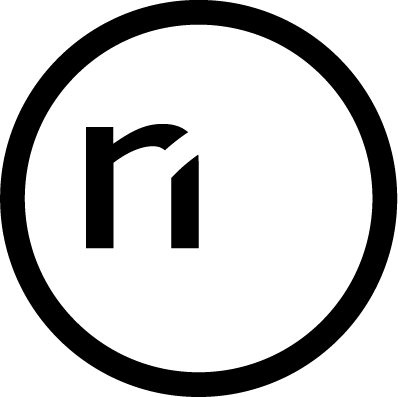How to express by hand
There are many situations where it is a good idea that you express your breast milk. This applies both immediately after birth and later during the breastfeeding period. For example, if:
- you are separated from your baby – for example, you are admitted to the maternity ward and your baby to the neonatal ward
- your baby needs extra nutrition for the first day or so.
- your baby is too weak to breastfeed – for example, if born prematurely or are sick
- the baby does not yet have the correct sucking technique
- you want to stimulate/increase your milk production, e.g. if you use a pacifier
- you have very sore or damaged nipples
- you have very tense breasts.
-
There are many situations where it is a good idea that you express your breast milk. This applies both immediately after birth and later during the breastfeeding period. For example, if:
- you are separated from your baby – for example, you are admitted to the maternity ward and your baby to the neonatal ward
- your baby needs extra nutrition for the first day or so.
- your baby is too weak to breastfeed – for example, if born prematurely or are sick
- the baby does not yet have the correct sucking technique
- you want to stimulate/increase your milk production, e.g. if you use a pacifier
- you have very sore or damaged nipples
- you have very tense breasts.
-
Hand expressing is gentlest on the nipples, and especially in the first day to two, is the most effective way to express milk. This is because there is not much milk yet, and it can therefore be lost in the milking kit. In addition, you get to know your breast better which can be useful later in the expressing and breastfeeding process.
The first day after birth, you can hand express for 5 minutes on each breast, preferably 7-8 times a day. We also recommend expressing 7-8 times a day when you switch to expressing using the pump.
It may be necessary to skip once at night in order for you to sleep. However, there should never be more than 6 hours between 2 milk express sessions, as your hormones are then influenced to reduce milk production.
After you have expressed, it will take at least 1 hour before the baby is able to feed so that you have time to form new milk.
-
The process is probably different than you expected, when it is necessary to begin your breastfeeding journey by expressing milk. You may have had a complicated birth, for example a premature birth, birth by caesarean section, lost a large amount of blood or been given medication during childbirth.
It can be stressful to express milk when you have just become a mother, need to get to know your baby and establish breastfeeding. It may be necessary for you to discuss together with the staff to try and find out whether the circadian rhythm needs to be changed so that you also get peace and rest.
These and many other factors can play a role in when your milk will come in. At the same time, there are many emotions associated with being admitted to the NICU that can affect milk production.
It is important that you do not lose heart if the milk comes in a little later than expected. It is natural for this to happen when you have had a complicated process. It is important to continue to stimulate your production when expressing, even though there may not be much in the beginning.
Every drop is a success
Milk production changes a lot over the first 1-9 days. During this period, you can assess with the staff whether it may be necessary to increase or decrease the number of express times. If your baby is born prematurely, it is expected that milk expressing will continue until the due date, though possibly only 1-2 times a day once the baby is breastfed fully.
Some women do not reach their goal of full milk volume or full breastfeeding. The most important thing is the good work you do and that you know that every drop does something good for your baby
Transition to breastfeeding
When your baby gets better at breastfeeding, you can gradually switch to full or partial breastfeeding. You can also express at one breast while breastfeeding your baby at the other.
If the baby is born prematurely, a withdrawal plan is made together with the staff, where the tube feeding is reduced as the baby eats more and more at the breast.
In the tapering plan, you must also take into account that stopping expressing milk too early can increase the risk of milk accumulation and breast inflammation. Likewise, you may risk that the amount of milk is reduced abruptly if expressing is suddenly stopped and the milk does not flow as quickly when the baby sucks. Always ask the staff for advice in relation to tapering down expressing.
-
Prepare for the milking
Start by washing or disinfecting your hands.
Prepare a cup, spoon or small syringe to collect the milk, depending on whether it is to be used immediately or stored.
Activate the milk by massaging your breast with gentle circular motions using 3 fingers for a minimum of 30 seconds. This should imitate the baby, who likes to lie and punch with his hands. At the same time, massaging stimulates the hormones that produce the milk.
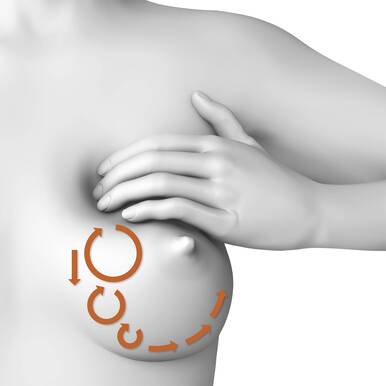
Activate the milk by massaging in gentle circular motions.
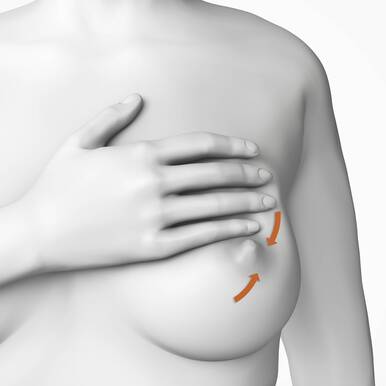
Stroke with light movements from the outer edge of the breast towards the nipple. Do this all around the chest. You may want to touch or squeeze the nipple to stimulate the hormones.
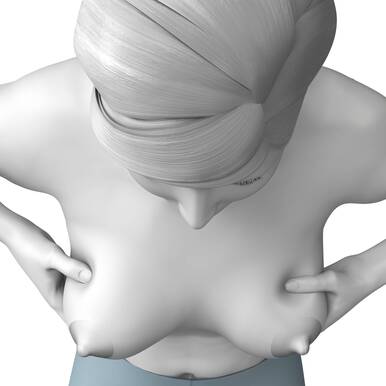
You can lean forward and move your upper body slightly to stimulate the hormones.
Position the grip correctly
Now you can start expressing in the following way.
Sit relaxed, possibly slightly leaning forward. With one hand, grasp the breast outside the areola (brown area) with your thumb on top and your index finger/middle finger underneath. This is where the glandular tissue begins. Let the rest of your hand rest against your chest.
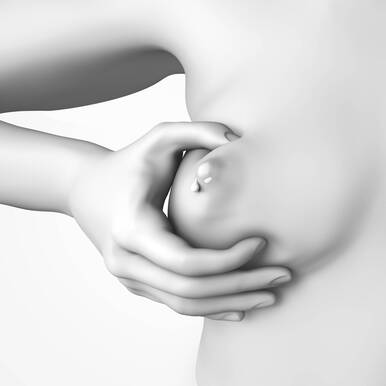
If you imagine a line between your fingers, it should go straight across.
Pull your fingers and the rest of your hand up and into your chest – towards your ribs. Pinch your fingers together while still keeping your grip in towards the ribs. You create a light rolling motion.
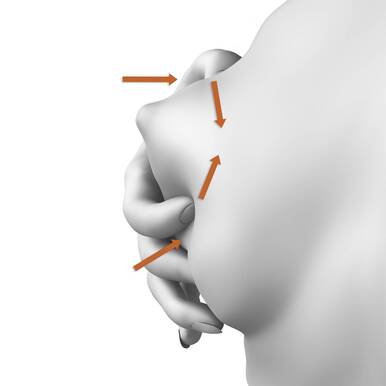
Pinch your fingers together while still holding the grip.
Loosen a little, squeeze again and find a rhythm that suits you. This should mimic your baby's sucking movements, and it activates your glands and hormones. For the first 30 seconds or so it may feel a little sore, then it passes.
A good rhythm can be 3 quick squeezes and then a 4th squeeze where you hold a deeper grip for a few seconds, or as long as the milk flows.
It may take some time before the milk starts to come. Be patient and continue with the rhythmic movements with your fingers. Relax and breathe deeply.
Finish expressing
When there is no more milk, loosen your entire grip and place your fingers so that they gradually move around the breast. If necessary, use the other hand for part of the chest.
Use heat to relax a tense chest
If you are further along the expressing process and your breasts are very tense, you can take a warm bath or put a warm compress on your breasts 2-5 minutes before you start expressing milk.
Practice the right technique
When expressing by hand, avoid:
- Pulling forward, as it is the glandular tissue you will be working with
- Squeezing so that it hurts. It's more rhythm and pressure that should do the work for you.
- Rubbing the fingers against the skin, so that it chafes and becomes sore
- Placing your fingers at an angle in which the nipple is not centred.
Make it a good time
- Relax. Sit comfortably and breathe deeply several times along the way.
- Privacy. If you need privacy, you may want to turn the chair around or ask the staff for a screen.
- Look at your baby. It can make it more pleasurable that your baby is lying with you while you are expressing, or that you have a picture of your baby with you. If your baby is in the Neonatal Unit, you can express by the baby if it makes you more relaxed.
- Listen to music. Some people enjoy listening to music whilst expressing.
Watch video with instructions on how to express by hand
See instructions on video here:
See instructions on video here:
https://aalborguh.RN.dk/udmalkning
You can also access the videos by scanning the QR code with the camera in your phone.
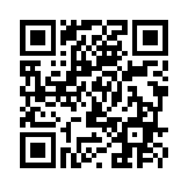
-
If you have any questions, please feel free to contact us.
Neonatal Units 12 and 13
Phone: 97 66 34 42
We are here 24/7.
